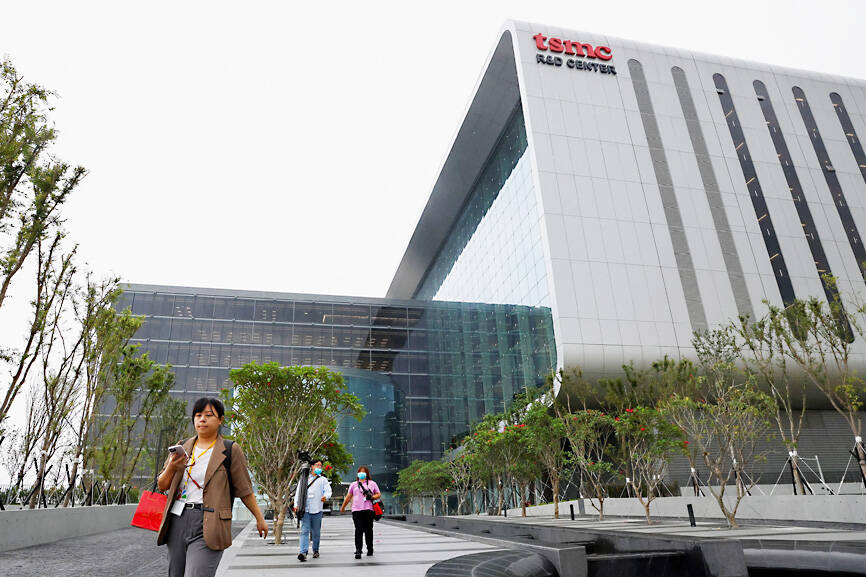Taiwan Semiconductor Manufacturing Co (TSMC, 台積電) yesterday posted its second-highest monthly revenue totaling NT$206.03 billion (US$6.57 billion) for last month on constant robust demand for its 3-nanometer chips used in iPhones, boding well as a sign that the chipmaker would hit its quarterly revenue target.
Revenue last month retreated to an annual contraction of 7.5 percent to NT$206.03 billion, compared with NT$222.71 billion. That represented a monthly decline of 15.3 percent from NT$243.2 billion in October, when its monthly revenue climbed to an all-time high.
In the first two months of this quarter, TSMC accumulated a combined NT$449.23 billion in revenue, achieving about 76 percent of the lower end of the chipmaker’s revenue guidance of US$18.8 billion. TSMC estimated in October that revenue this quarter would expand about 11 percent sequentially.

Photo: Reuters, Ann Wang
The Hsinchu-based company at the time attributed the revenue growth to strong demand for its 3-nanometer and 5-nanometer technology used to make smartphones and artificial intelligence (AI) chips, providing a cushion to weakness in chips used in other applications due to a longer-than-expected inventory correction cycle.
TSMC is keeping a high utilization of about 90 percent for its 3-nanometer technology equipment during the current quarter, and the figure is to be elevated to about 95 percent in the first half of next year and rise even higher in the second half, an International Data Corp’s (IDC) projection on Thursday showed.
TSMC is benefiting from the rollout of new flagship smartphone processors by customers such as MediaTek Inc (聯發科), Qualcomm Inc, Intel Corp and Advanced Micro Devices Inc (AMD), who are to join Apple in adopting TSMC’s 3-nanometer chips during the second half of next year, IDC senior research manager Galen Zeng (曾冠緯) said.
Apple is to go one step further by using TSMC’s enhanced version of 3-nanometer technology for its newest A18 processor next year, Zeng said.
With a broader customer base, TSMC expects 3-nanometer chips to contribute a greater revenue share next year, compared with about 5 percent this year, the first year it ramped up production of the foundry industry’s most advanced process technology.
TSMC also plans to maintain a high equipment utilization rate for its 4-nanometer and 5-nanometer technologies for the entirety of next year at more than 80 percent, given the lofty demand for AI processors and AI accelerators, Zeng said.
To satiate customers’ strong appetite for AI chips, primarily from Nvidia Corp, TSMC is planning to more than double its capacity for advanced packaging technology, or chip-on-wafer-on-substrate (CoWoS) technology to solve its supply deficiency.
TSMC still faces a 20 percent supply gap to fill, Zeng said, adding that the supply constraints are to ease in the second half of next year, when TSMC is to complete its CoWoS capacity expansion.
TSMC’s CoWoS capacity is to surge about 130 percent to 32,000 wafers per month by the end of next year, up from 14,000, Zeng estimated.
That was an upgrade from an earlier estimate three months prior of 28,000 wafers, due to faster equipment acquisitions, he said.
The global semiconductor market is to resume annual growth of 20.2 percent next year to US$633 billion, up from US$527 billion this year, attributable to growing demand for AI-related chips, vehicle chips and a recovery of memory chips, IDC predicted.
This year would be a tough year, with the market size set to shrink 12 percent annually, the researcher forecast.

With an approval rating of just two percent, Peruvian President Dina Boluarte might be the world’s most unpopular leader, according to pollsters. Protests greeted her rise to power 29 months ago, and have marked her entire term — joined by assorted scandals, investigations, controversies and a surge in gang violence. The 63-year-old is the target of a dozen probes, including for her alleged failure to declare gifts of luxury jewels and watches, a scandal inevitably dubbed “Rolexgate.” She is also under the microscope for a two-week undeclared absence for nose surgery — which she insists was medical, not cosmetic — and is

CAUTIOUS RECOVERY: While the manufacturing sector returned to growth amid the US-China trade truce, firms remain wary as uncertainty clouds the outlook, the CIER said The local manufacturing sector returned to expansion last month, as the official purchasing managers’ index (PMI) rose 2.1 points to 51.0, driven by a temporary easing in US-China trade tensions, the Chung-Hua Institution for Economic Research (CIER, 中華經濟研究院) said yesterday. The PMI gauges the health of the manufacturing industry, with readings above 50 indicating expansion and those below 50 signaling contraction. “Firms are not as pessimistic as they were in April, but they remain far from optimistic,” CIER president Lien Hsien-ming (連賢明) said at a news conference. The full impact of US tariff decisions is unlikely to become clear until later this month

GROWING CONCERN: Some senior Trump administration officials opposed the UAE expansion over fears that another TSMC project could jeopardize its US investment Taiwan Semiconductor Manufacturing Co (TSMC, 台積電) is evaluating building an advanced production facility in the United Arab Emirates (UAE) and has discussed the possibility with officials in US President Donald Trump’s administration, people familiar with the matter said, in a potentially major bet on the Middle East that would only come to fruition with Washington’s approval. The company has had multiple meetings in the past few months with US Special Envoy to the Middle East Steve Witkoff and officials from MGX, an influential investment vehicle overseen by the UAE president’s brother, the people said. The conversations are a continuation of talks that

Nintendo Co hopes to match the runaway success of the Switch when its leveled-up new console hits shelves on Thursday, with strong early sales expected despite the gadget’s high price. Featuring a bigger screen and more processing power, the Switch 2 is an upgrade to its predecessor, which has sold 152 million units since launching in 2017 — making it the third-best-selling video game console of all time. However, despite buzz among fans and robust demand for pre-orders, headwinds for Nintendo include uncertainty over US trade tariffs and whether enough people are willing to shell out. The Switch 2 “is priced relatively high”